 ICACT20230069 Slide.00
[Big Slide]
[YouTube] ICACT20230069 Slide.00
[Big Slide]
[YouTube] |
Chrome  Click!! Click!! |
 |
Good day everyone, to day, I will present about our research and the title is Redesign of Indonesia E-commerce Online Review using User Information Behavior and �Build-Learn-Measure Approaches. We are a research team from Telkom Univ-Indonsia, Multimedia Univ-Malaysia, Medan State Univ-Indonesia. I am Dana S. Kusumo and our member are Dita Noviyanti , Arfive Gandhi, Ichwanul Muslim K., Su-Cheng Haw, Palanichamy Naveen.
|
 ICACT20230069 Slide.01
[Big Slide]
[YouTube] ICACT20230069 Slide.01
[Big Slide]
[YouTube] |
Chrome  Click!! Click!! |
 |
Good day everyone, to day, I will present about our research and the title is Redesign of Indonesia E-commerce Online Review using User Information Behavior and �Build-Learn-Measure Approaches. We are a research team from Telkom Univ-Indonsia, Multimedia Univ-Malaysia, Medan State Univ-Indonesia. I am Dana S. Kusumo and our member are Dita Noviyanti , Arfive Gandhi, Ichwanul Muslim K., Su-Cheng Haw, Palanichamy Naveen. |
 ICACT20230069 Slide.02
[Big Slide] ICACT20230069 Slide.02
[Big Slide]
|
Chrome  Click!! Click!! |
 |
Online review in an e-commerce is used to help potential user to make decision to buy. To make user easier to get the benefit of the online review, the design of the online review must consider user behavior when interacting with the online review. User information behavior can be used in e-commerce to observe the best experience for user when interacting with e-commerce. To support the decision to buy, the information detail of a product in the review section can be add with more detailed information and also make information about product rating easier to find. Based on our experience, when compared to a focused product review platform in Indonesia, online review features in one of the biggest e-commerce platforms in Indonesia lacked the aforementioned detail aspects. Therefore, in this study we redesigned the online review feature by adding more detailed information and considering user information behavior. In addition, to get validated learning from users to reduce the risk to build not optimal product, in this research we used the build-measure-learn approach from the lean startup as a method to redesign an existing online review feature from one of the biggest e-commerce platforms in Indonesia.
|
 ICACT20230069 Slide.03
[Big Slide] ICACT20230069 Slide.03
[Big Slide]
|
Chrome  Click!! Click!! |
 |
Online review in an e-commerce is used to help potential user to make decision to buy. To make user easier to get the benefit of the online review, the design of the online review must consider user behavior when interacting with the online review. User information behavior can be used in e-commerce to observe the best experience for user when interacting with e-commerce. To support the decision to buy, the information detail of a product in the review section can be add with more detailed information and also make information about product rating easier to find. Based on our experience, when compared to a focused product review platform in Indonesia, online review features in one of the biggest e-commerce platforms in Indonesia lacked the aforementioned detail aspects. Therefore, in this study we redesigned the online review feature by adding more detailed information and considering user information behavior. In addition, to get validated learning from users to reduce the risk to build not optimal product, in this research we used the build-measure-learn approach from the lean startup as a method to redesign an existing online review feature from one of the biggest e-commerce platforms in Indonesia.
|
 ICACT20230069 Slide.04
[Big Slide] ICACT20230069 Slide.04
[Big Slide]
|
Chrome  Click!! Click!! |
 |
Mudambi and Schuff clearly state that product kind, review depth, and review extremity have an impact on how useful a review is regarded to be. Although the product type moderates the impact of review depth on review usefulness, review depth has a positive impact on review usefulness. These findings are also strengthened by Flanagin et al. , their survey results indicate that consumers rely more heavily on web-based information than other channels, and that ranking information is very important in evaluating the credibility of online commercial information. Salehan et al. find that the behavior of customer in previous order worthy to be considered in providing recommendations.
= Consumers' views toward a product were improved by including product information in mobile commerce and whether this relationship was influenced by consumers' consumption objectives [1].
|
 ICACT20230069 Slide.05
[Big Slide] ICACT20230069 Slide.05
[Big Slide]
|
Chrome  Click!! Click!! |
 |
There are three important aspects in an e-commerce human-computer interaction: Web usability, interface design, and trust. A rating can support trust and reputation in an e-commerce design. Rating the acquired goods is one of the user activities in online shopping. Ratings are favourably correlated with opinions about the quality of the product and buy intent.
|
 ICACT20230069 Slide.06
[Big Slide] ICACT20230069 Slide.06
[Big Slide]
|
Chrome  Click!! Click!! |
 |
Interface design is a major factor affecting the profitability in e-commerce. Consumers' views toward a product were improved by including product information in mobile commerce and whether this relationship was influenced by consumers' consumption objectives . Hwang et al. conducted two field studies in which we polled parents in Korea and the USA about their opinions of two recently created childcare hybrid products (HPs) from Samsung Electronics . The findings showed that individuals who had access to more information about the HPs had a more positive opinion of them than those who had not. But when a consumption objective was engaged, this association vanished. The research shows a dynamic interaction between information seeking and consuming objectives, which challenges designers to re-evaluate existing best practices in the context of mobile commerce . In addition, having a good interface design, it can significantly affects the perceived security of e-commerce portals .
Liu et. al. narrated User Information Behavior (UIB) as network users¡¯ information acquisition, creation, interaction, and utilization via mobile social networks . Previously, Haiyan and Lihui emphasized UIB as a response to the external environment under the control of cognitive thinking following the information needs and ideological motivations . Du et. al. also reminded that UIB data could be generated by people's behavior on reading, sharing, collecting, and related activities in a media . It derived from a result of the mutual influence and interaction of many individual users . It has an essential impact on the enterprises' innovation campaign .
|
 ICACT20230069 Slide.07
[Big Slide] ICACT20230069 Slide.07
[Big Slide]
|
Chrome  Click!! Click!! |
 |
Ries proposed the build-measure-learn approach, as part of the Learn Startup, to validate and learn from the customers¡¯ feedback . Therefore, this approach can mitigate software project¡¯s risks early in the beginning of project by testing hypothesis (in this research as a design challenge). Therefore, with the build-measure-learn, a software project can get rapid feedback before the final product released.
|
 ICACT20230069 Slide.08
[Big Slide] ICACT20230069 Slide.08
[Big Slide]
|
Chrome  Click!! Click!! |
 |
Riihiaho in 2017 stated the usability testing as a user testing method which enable representative users to perform the tasks or describe their intentions under observation [12]. It has four basic phases: (1) Design and preparation of the tests; (2) Conducting the test sessions; (3) Analysing the results; and (4) Communicating the results. It can generate insights that explain how and why participants make certain choices when using a prototype or their overall assessment of the utility . Riihiaho also mention several specific usability testings based on its certain purpose and technical issues, such as traditional usability testing, backtracking analysis, paired-user testing, peer tutoring, pluralistic usability walkthrough, and others . To test the prototype from the build stage, in this research we used an initial usability testing .
|
 ICACT20230069 Slide.09
[Big Slide] ICACT20230069 Slide.09
[Big Slide]
|
Chrome  Click!! Click!! |
 |
We used a hypothesis as a baseline to redesign the feature. The online review feature was redesigned because the information lacks detail and information about product is simple, so it may not give trust and helpful information for its users to make decision to buy. This was also supported by one of the authors¡¯ experiences when compared to femaledaily.com which has more detailed information in the review feature. Therefore, the design challenge that we used as a hypothesis was, adding more detail information can help the user when interacting with the e-commerce¡¯s online review.
|
 ICACT20230069 Slide.10
[Big Slide] ICACT20230069 Slide.10
[Big Slide]
|
Chrome  Click!! Click!! |
 |
The first method we used is the build. |
 ICACT20230069 Slide.11
[Big Slide] ICACT20230069 Slide.11
[Big Slide]
|
Chrome  Click!! Click!! |
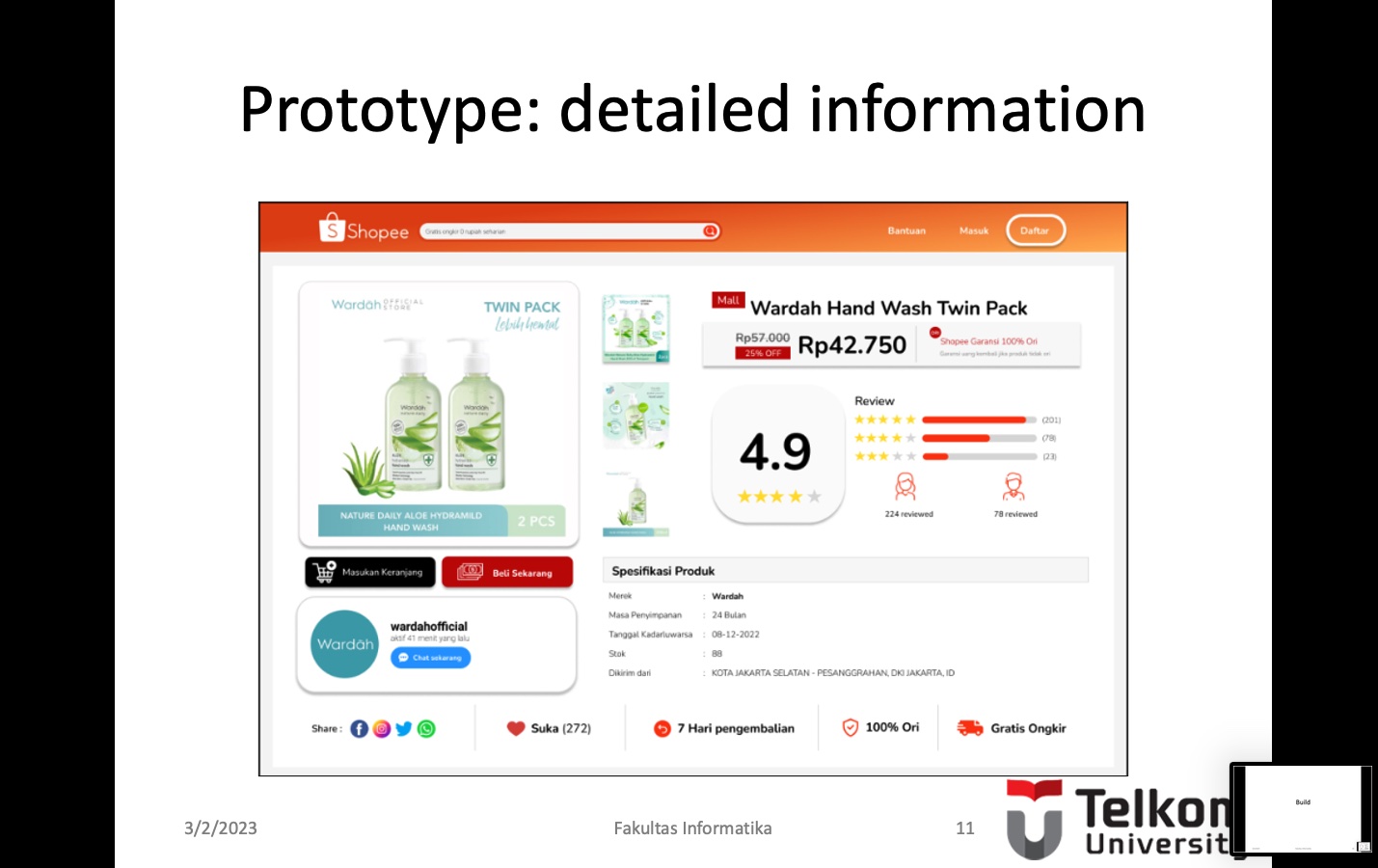 |
Based on the hypothesis, first we added detailed information.
|
 ICACT20230069 Slide.12
[Big Slide] ICACT20230069 Slide.12
[Big Slide]
|
Chrome  Click!! Click!! |
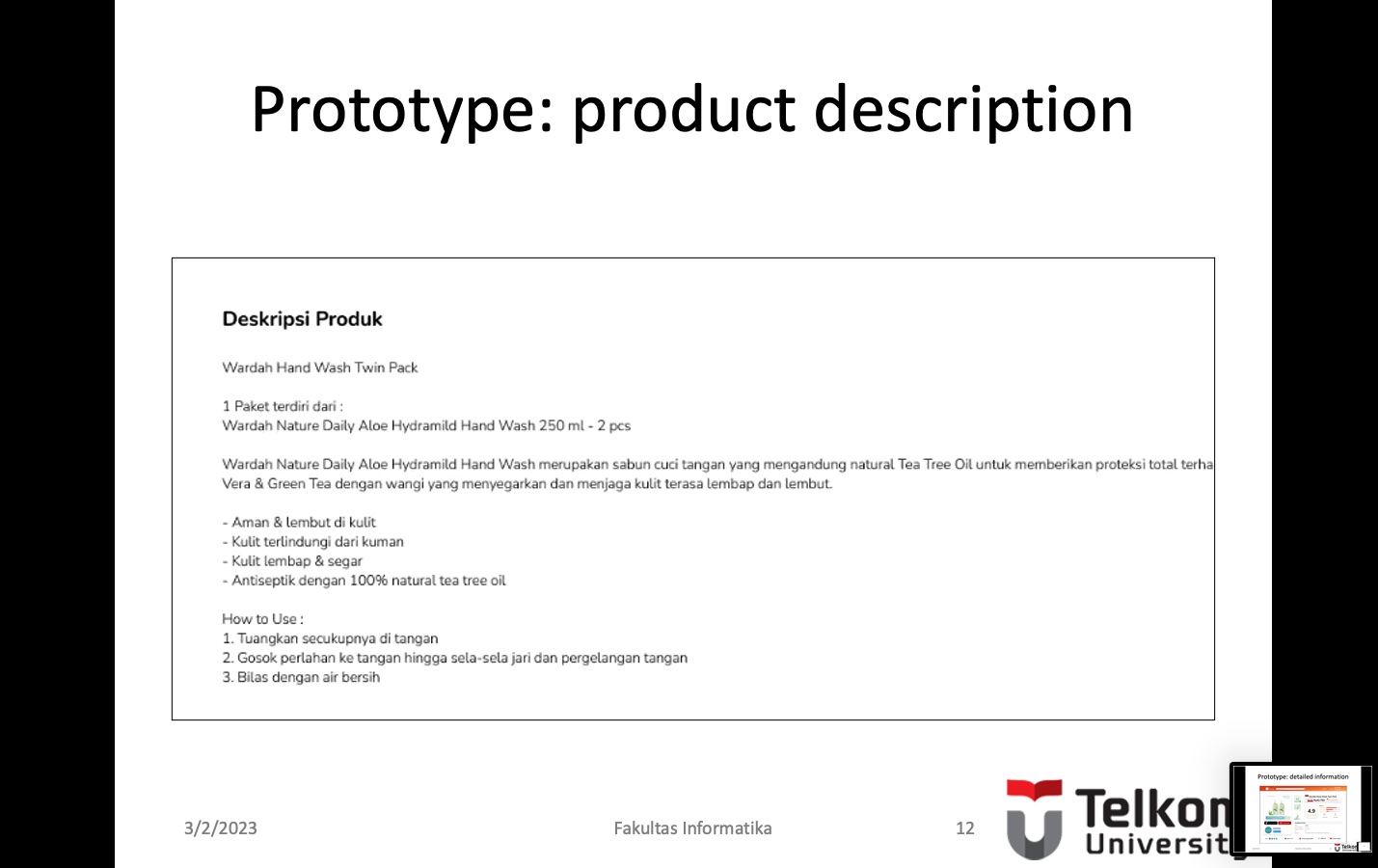 |
Then we added product description. |
 ICACT20230069 Slide.13
[Big Slide] ICACT20230069 Slide.13
[Big Slide]
|
Chrome  Click!! Click!! |
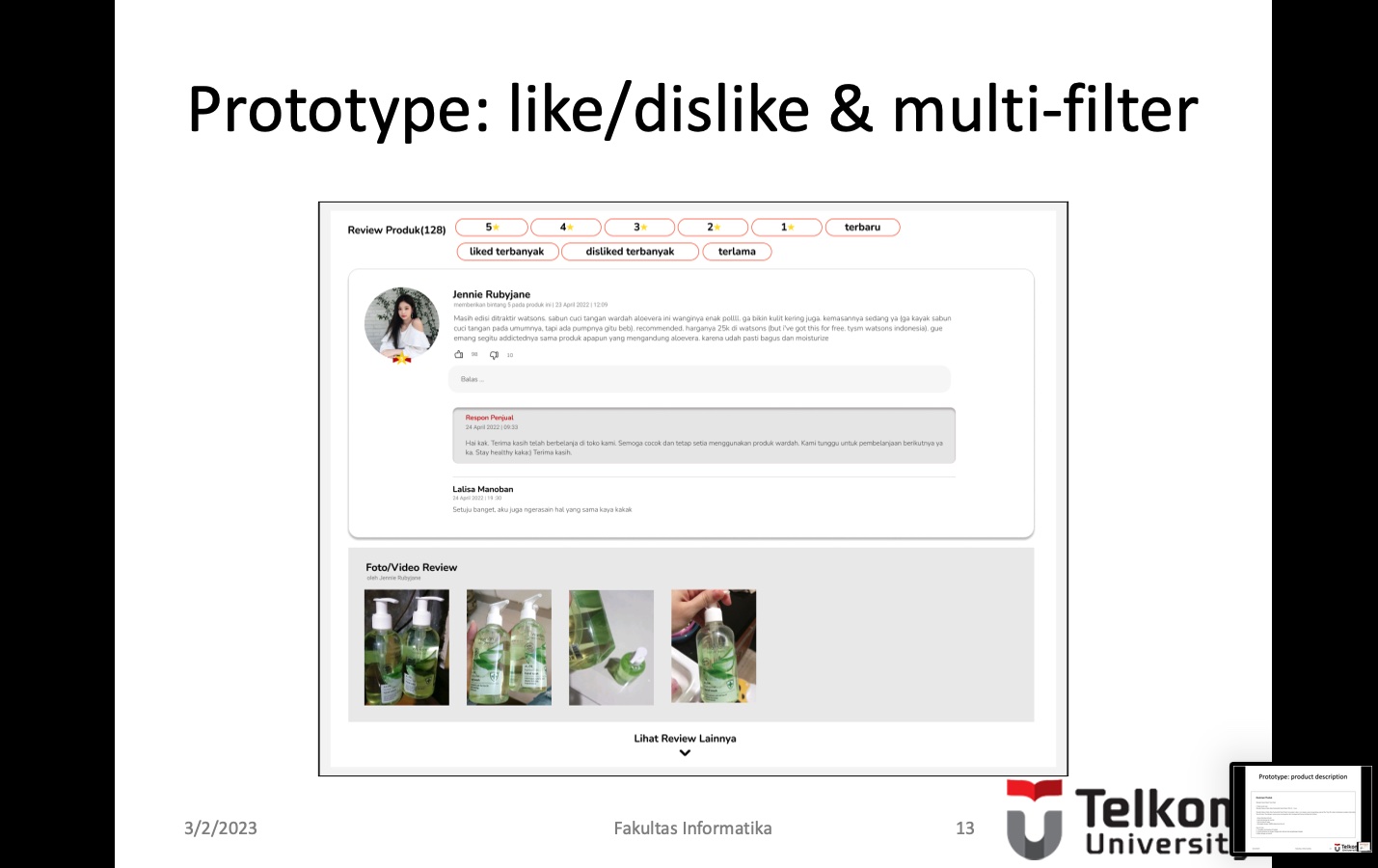 |
Lastly, we added a like/dislike feature and a multi-filter (user can apply more than one filter at the same time) in the online review feature.
|
 ICACT20230069 Slide.14
[Big Slide] ICACT20230069 Slide.14
[Big Slide]
|
Chrome  Click!! Click!! |
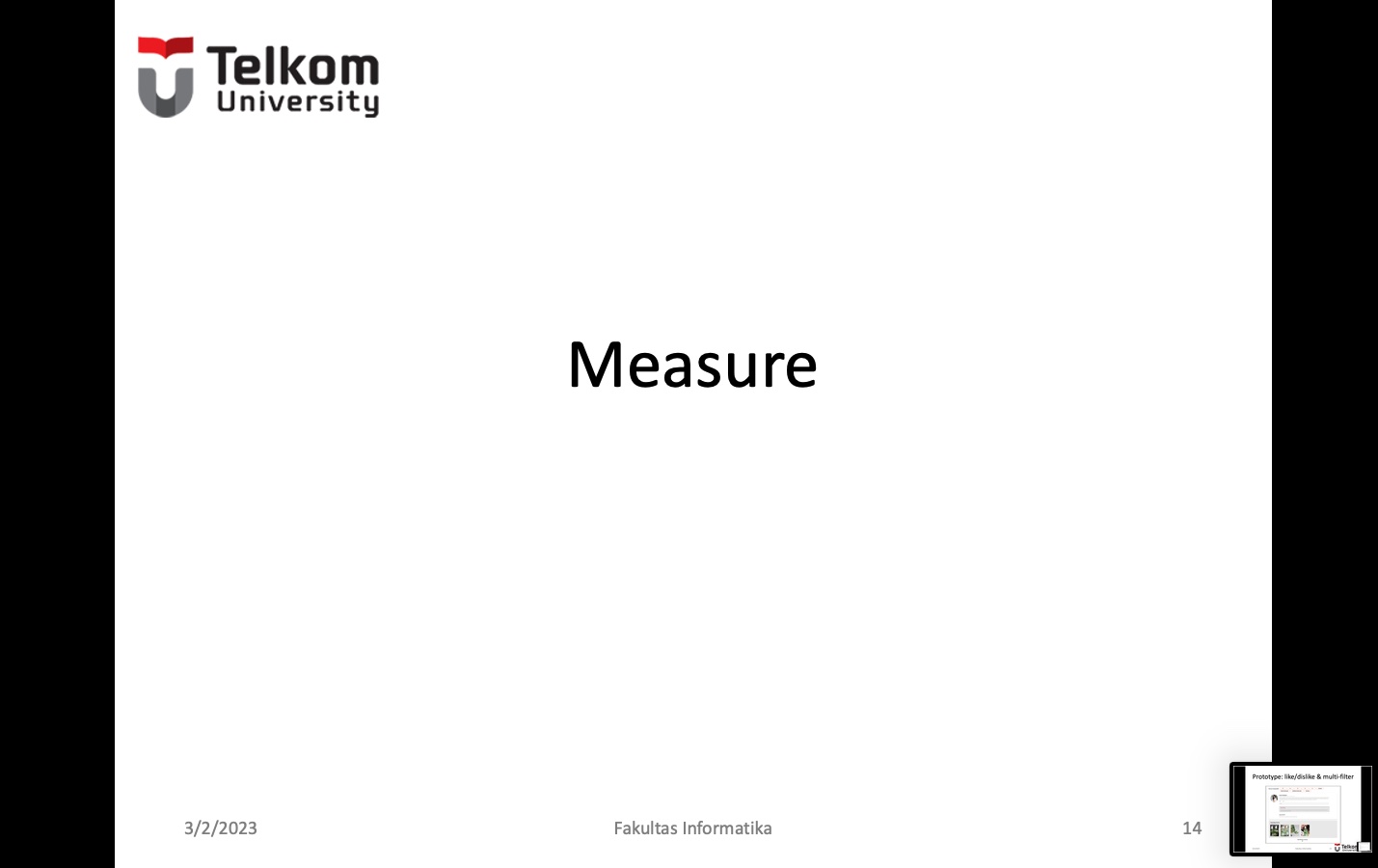 |
The second phase is Measure. |
 ICACT20230069 Slide.15
[Big Slide] ICACT20230069 Slide.15
[Big Slide]
|
Chrome  Click!! Click!! |
 |
In the measure stage, we conducted an initial usability testing so that we can get rapid feedback and validated learning from potential users. In this research, we invited 17 participants but only 10 participants agreed to involve in our study. In this study we compared the online review page of the e-commerce with the improved review feature based on our hypothesis using A/B Testing. The A/B Testing used maze tools. The participants used different maze tools to test design A (the original design) and design B (the redesign). In the maze we gave a task sequence to scroll down and push ¡°See other reviews¡± button and to push 4 and 5 star rating. There were additional questions in the task, and we also collected interaction information when users navigated in the maze.
|
 ICACT20230069 Slide.16
[Big Slide] ICACT20230069 Slide.16
[Big Slide]
|
Chrome  Click!! Click!! |
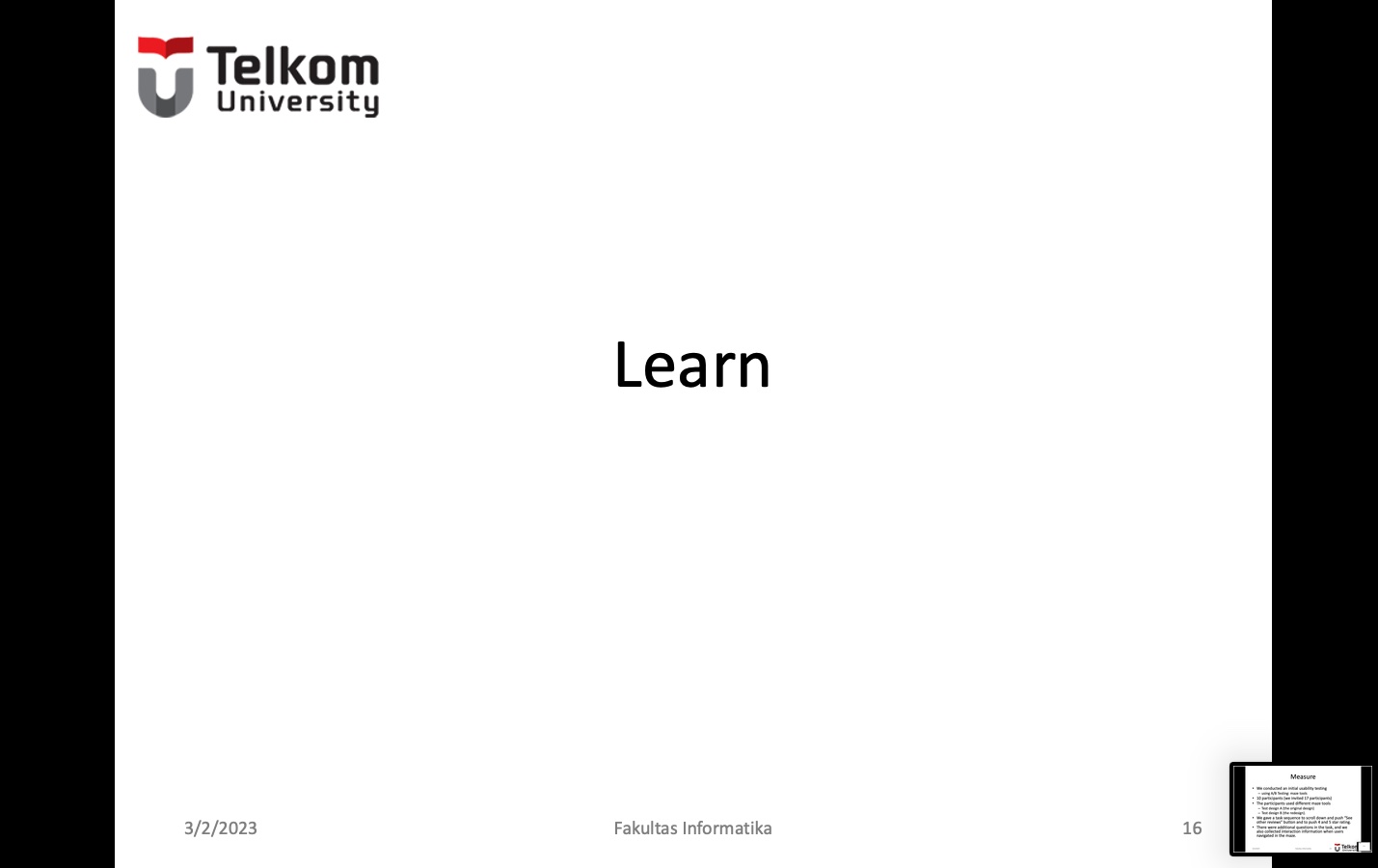 |
The last phase is Learn. |
 ICACT20230069 Slide.17
[Big Slide] ICACT20230069 Slide.17
[Big Slide]
|
Chrome  Click!! Click!! |
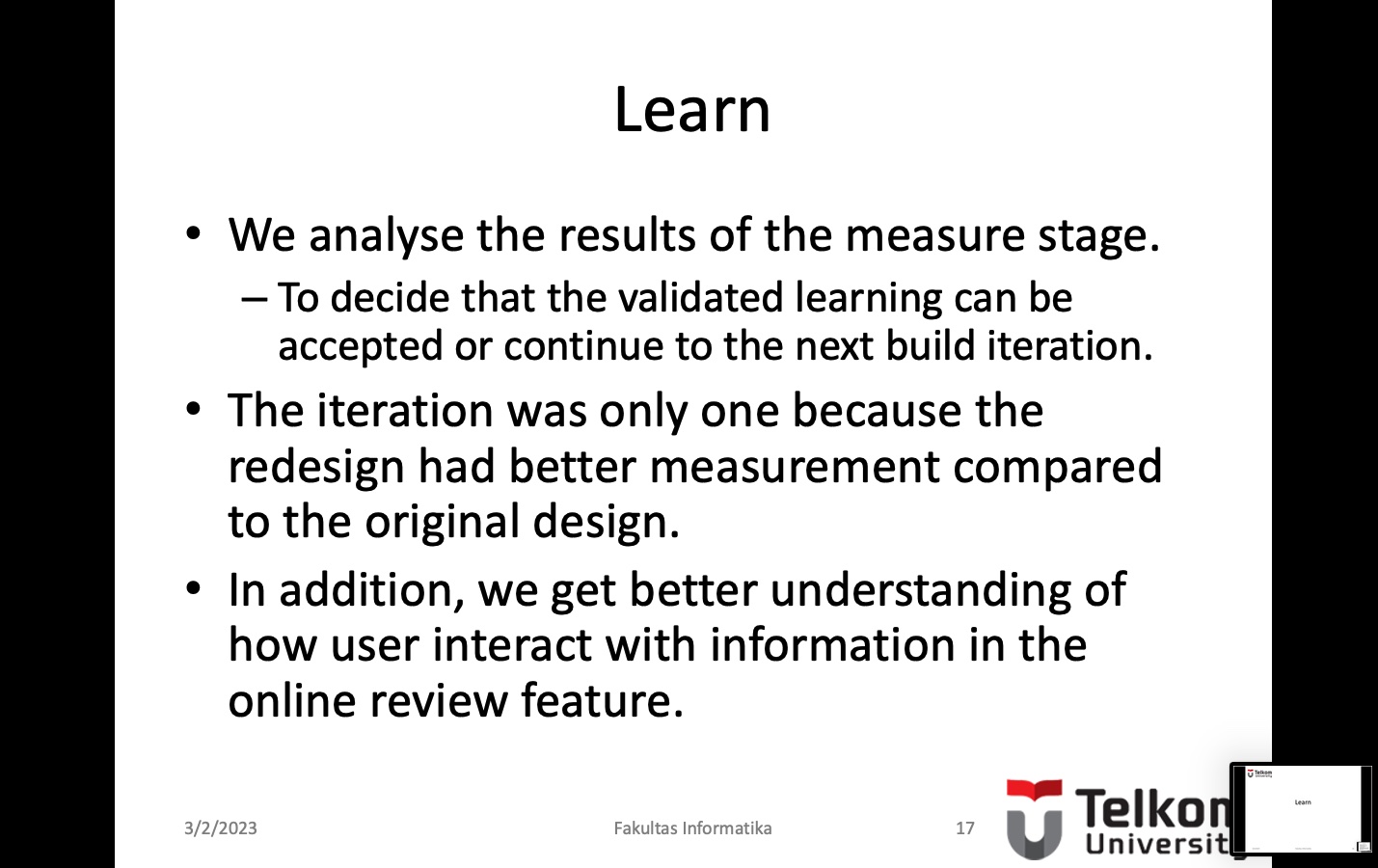 |
In the learn stage, we analyse the results of the measure stage. The purpose of this stage is to decide that the validated learning can be accepted or continue to the next build iteration. Based on our results, the iteration was only one because the redesign had better measurement compared to the original design. In addition, we get better understanding of how user interact with information in the online review feature.
|
 ICACT20230069 Slide.18
[Big Slide] ICACT20230069 Slide.18
[Big Slide]
|
Chrome  Click!! Click!! |
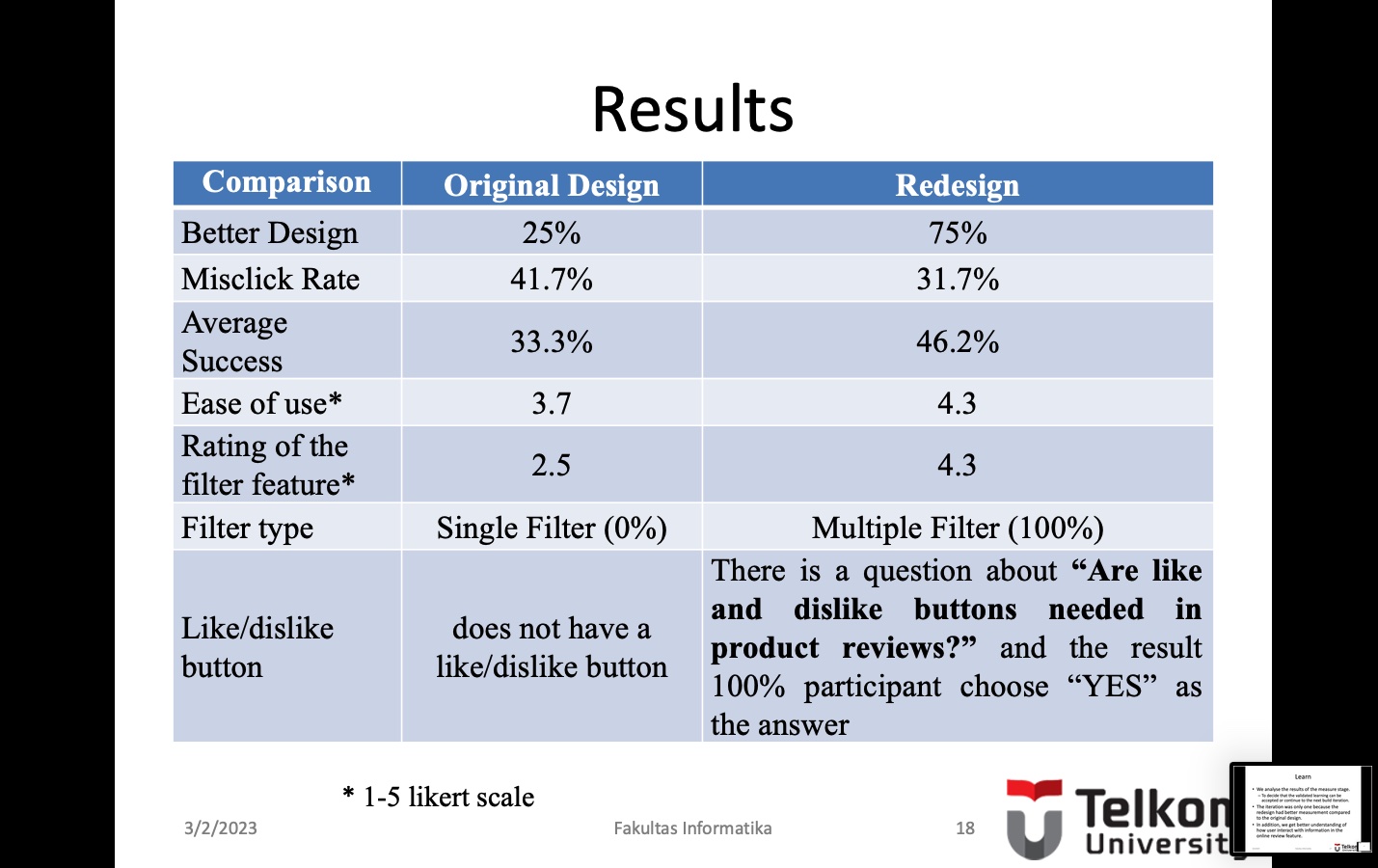 |
Based on the above results, the addition of the description and more detailed product information in the review section, make participants to more preferable in using the redesign. It explains why the participants had lower misclick rate in the redesign and higher average success (compared to original design). These results were supported with heatmap (in the paper) showing that the redesign gave direct rating information (added information).
We found that 83% participants read the review when they search a product information in the e-commerce to find the product detail. In addition, all participants agreed that the product review can help them to get more detailed information on the searched products. All participants also agreed that the multiple filter can help them to get more specific product information faster, compared to only use one filter at the same time (a single filter feature). Therefore, these measurement results show that our redesign had supported the user information behavior when users use and interact with the e-commerce¡¯s online review feature.
|
 ICACT20230069 Slide.19
[Big Slide] ICACT20230069 Slide.19
[Big Slide]
|
Chrome  Click!! Click!! |
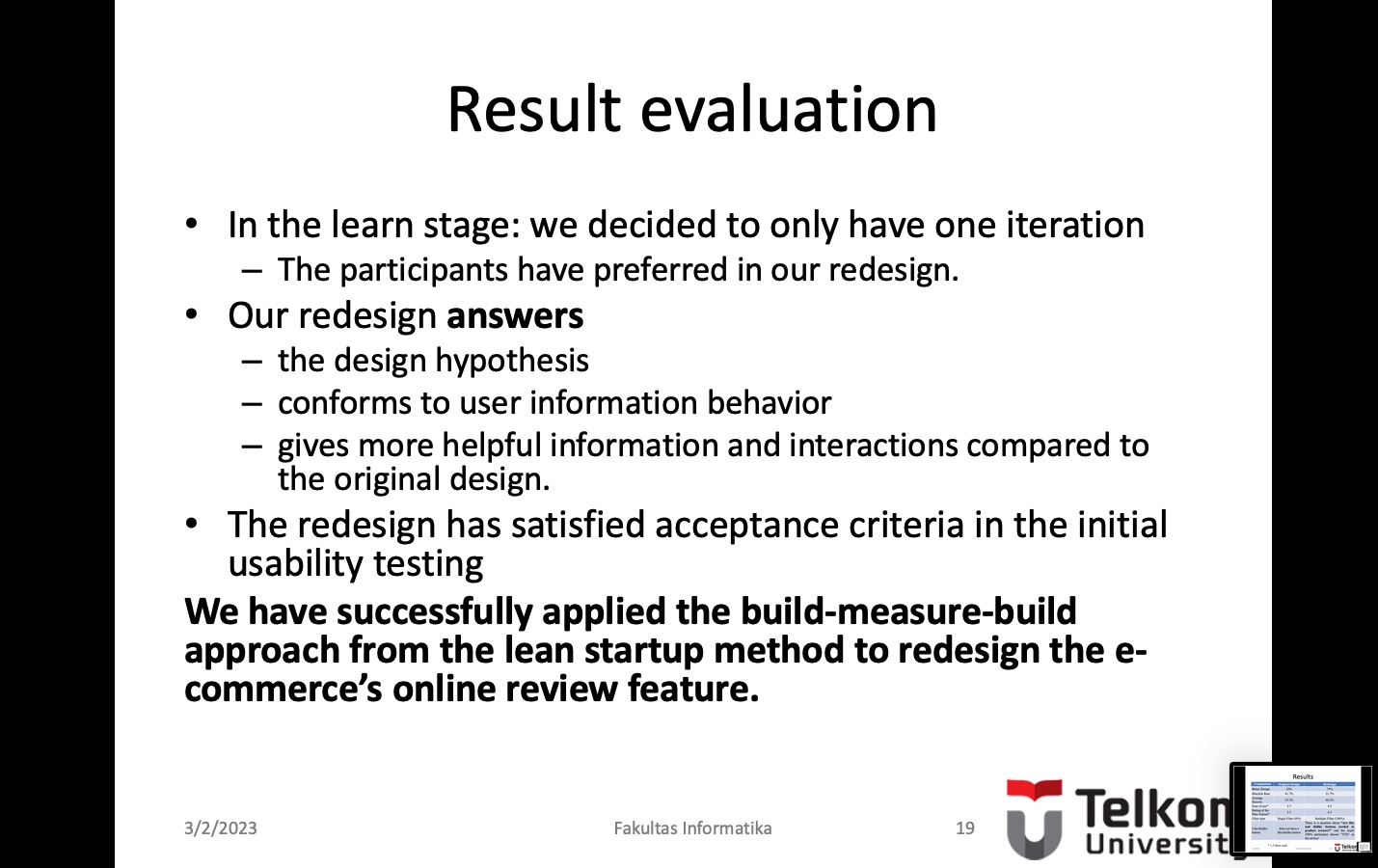 |
In the learn stage, we decided to only have one iteration because the participants have preferred in our redesign. It shows that our redesign answers the design hypothesis, conforms to user information behavior and gives more helpful information and interactions compared to the original design. It can be concluded that the redesign has satisfied acceptance criteria in the initial usability testing . So that, we have successfully applied the build-measure-build approach from the lean startup method to redesign the e-commerce¡¯s online review feature.
|
 ICACT20230069 Slide.20
[Big Slide] ICACT20230069 Slide.20
[Big Slide]
|
Chrome  Click!! Click!! |
 |
This research aimed to redesign and improve the online review feature on one of the biggest e-commerce in Indonesia. The build-measure-learn was used to redesign it because the method can get a fast feedback and validated learning. In the build stage, we departed from the hypothesis that the online review feature was redesigned because the information lacks detail. Therefore, we used design aspects for the online review supported by the previous work. In the measure stage, we used an initial usability testing to test the build results and to get rapid feedback. The feedback was evaluated in the learn stage. In the learn, we decided to only have one iteration because the results showed that the redesign was better than the original design, had answer the hypothesis and have had in accordance with user information behavior theory in e-commerce. Therefore, the redesign has successfully met the acceptance criteria for the redesign.
|
 ICACT20230069 Slide.21
[Big Slide]
[YouTube] ICACT20230069 Slide.21
[Big Slide]
[YouTube] |
Chrome  Click!! Click!! |
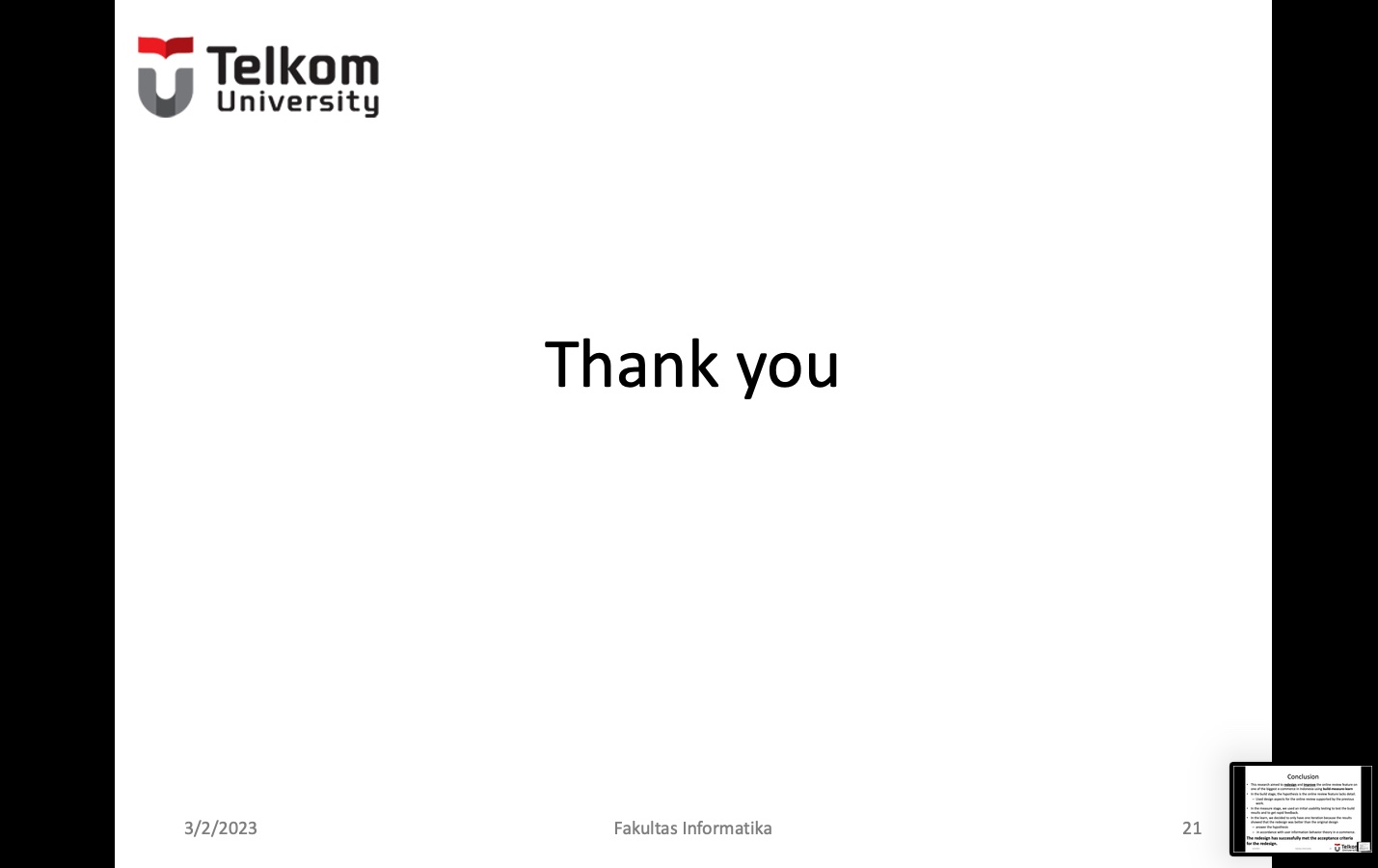 |
Thank you for attending my presentation. Your valuable feedback is welcomed. |






